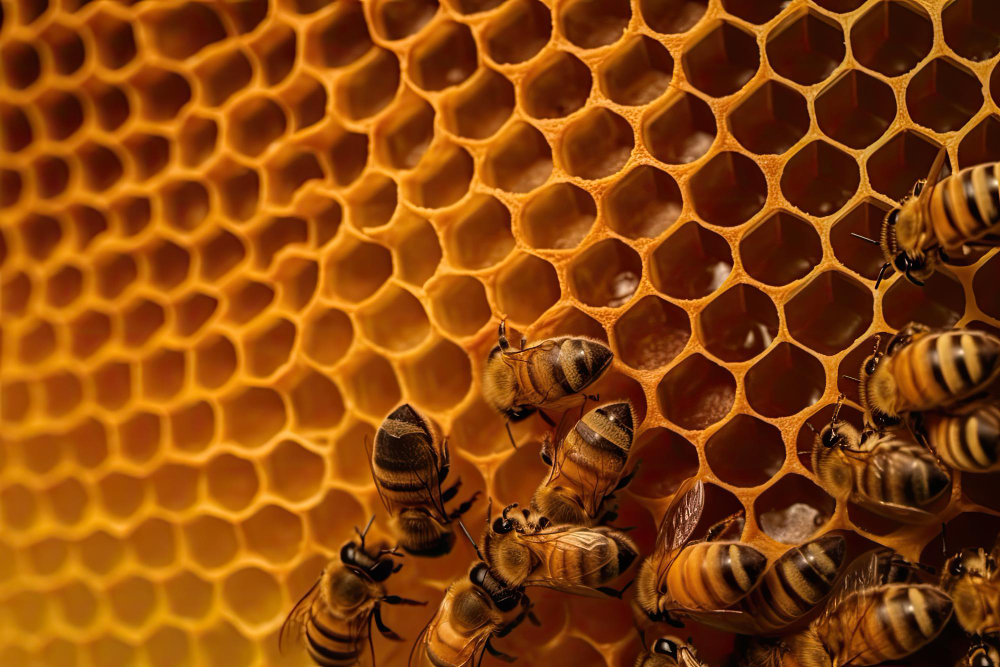Beekeeping, also known as apiculture, is an important practice that involves the cultivation, rearing, and extraction of honey from bees. This lesson covers key elements of beekeeping, including various Indian bee breeds like the Indian Rock bee, the design and hexagonal pattern of bee hives, the social organization of bees, and the distinction between male and female honey bees.
Indian Bee Breeds:
India is home to several bee breeds, each with its unique characteristics. One prominent Indian bee breed is the Indian Rock bee (Apis dorsata), known for its large size and aggressive nature. It builds nests on high tree branches and cliffs using a combination of wax and resin.
Bee Hives and the Hexagonal Structure:

Bee hives serve as the habitat for bee colonies and are essential to successful beekeeping practice. The most commonly used hive is the Langstroth hive, consisting of multiple rectangular boxes stacked vertically. Bees build honeycomb cells on frames within these boxes.
The honeycomb cells have a hexagonal structure. This hexagonal shape allows for efficient use of space and provides structural stability within the hive. Bees construct these cells using beeswax.
Social Polymorphism of Bees:
Bees are highly social creatures that thrive in well-structured colonies. Within a bee colony, there are three primary types of bees:
Queen Bee: Bees are highly social creatures that reside in well-structured colonies. Her primary role is to lay eggs and ensure the survival of the colony. She is noticeably larger and mates with drones to ensure the fertilization of her eggs.
Worker Bees: Worker bees are sterile females responsible for non-reproductive tasks within the colony. They perform various tasks such as foraging for nectar and pollen, building and maintaining the hive, feeding the larvae, and protecting the colony. They carry out most of the tasks necessary for maintaining the colony.
Drones: Drones are male bees. Drones primarily exist to mate with the queen and do not participate in other responsibilities within the colony. Drones do not possess stingers and are larger in size compared to worker bees.
The differentiation of sex in honey bees involves several distinct phases and biological processes, including the role of royal jelly, haploidy, and meiosis. Let's explore the process in more detail:
Determination of Egg Fertilization:
The sex of honey bees is determined by whether or not an egg is fertilized. During her nuptial flight, the queen bee mates with drones and stores their sperm in a specialized organ known as the spermatheca. The queen then fertilizes the eggs as she lays them.
Haploid Development:
Unfertilized eggs, which do not receive sperm from the queen, develop into haploid individuals. Haploid means they have a single set of chromosomes, derived entirely from the mother.
Drone Development:
Unfertilized eggs that develop into drones undergo haploid development. Drones, the male members of the colony, are bigger in size compared to worker bees. They have no father, and their genetic material consists solely of the mother's chromosomes.
Worker and Queen Bee Development:
Fertilized eggs, which receive sperm from the queen, develop into diploid individuals. Diploid refers to having two complete sets of chromosomes—one inherited from each parent.
a) Worker Bee Development:
Sterile female worker bees originate from fertilized eggs. Their larvae are nourished with a blend of pollen and nectar called bee bread. They do not receive royal jelly in their diet. During their development, worker bees go through different stages, including larval, pupal, and adult stages.
b) Queen Bee Development:
Queen bees also develop from fertilized eggs, but their development is different from that of worker bees. The larvae destined to become queens are fed copious amounts of royal jelly, a protein-rich secretion produced by worker bees. The royal jelly triggers specific physiological changes in the larvae, allowing them to develop into queens. These changes include accelerated growth, reproductive organ development, and changes in morphology.
Bees produce honey, beeswax, propolis, and royal jelly, each with its own unique value and purpose:
Honey: Bees collect nectar from flowers, transform it through enzymatic processes, and store it in honeycombs. The water content is then reduced through fanning and evaporation, resulting in honey. Honey serves as a food source for bees and has significant value for humans. It is a natural sweetener, packed with antioxidants, enzymes, vitamins, and minerals. Honey also possesses antibacterial properties and is used in traditional medicine and various culinary applications.
Beeswax: Beeswax is secreted by worker bees from special glands and is used to construct the honeycomb structure. It provides a sturdy foundation for the hive and serves as storage for honey and developing larvae. Beeswax has numerous uses beyond the hive. It is utilized in candle-making, cosmetics, skincare products, pharmaceuticals, and as a coating for cheeses. It also possesses natural moisturizing and protective properties.
Propolis: Bees gather resin from tree buds and combine it with their saliva and enzymes to produce propolis. This sticky substance is used to seal cracks and gaps in the hive, providing insulation and protection against pathogens. Propolis has antimicrobial, antifungal, and antioxidant properties. It is used in alternative medicine, dental products, and as a natural remedy for various ailments.
Royal Jelly: Royal jelly is a highly nutritious substance secreted by worker bees. It is the exclusive diet of the queen bee throughout her life and is crucial for her development and fertility. Royal jelly contains a high concentration of proteins, vitamins, minerals, and growth-promoting substances. It is believed to have potential health benefits and is used in dietary supplements, cosmetics, and traditional medicine.